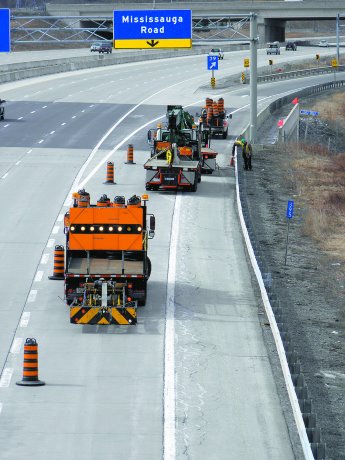In November 2012 a Dufferin Construction vehicle was parked on the hard shoulder of a Highway 401 express lane to allow two crewmembers to access a road construction sign that required changing.
The parking space was so tight that crewmembers had to exit the vehicle through a window and climb onto the road barrier to reach the sign. While the crew worked, a transport truck struck their vehicle, which erupted into a fireball.
The incident is just one of many concerns, which have prompted a current review by the Ontario Ministry of Transportation (MTO) of its Temporary Conditions Traffic Management Manual — often referred to as the TC-64 Signing Manual — which provides guidance to transportation practitioners on advance notification, advance warning, and alternate route signing for temporary conditions in work zones.
The manual was developed in 2001 by MTO’s Central Region Traffic Office but is also used as a reference by other Ontario regions.
"Even though the strategies outlined in the manual are still applicable, there is the need to update it to reflect the more complex work zone environments and technological changes that motorists encounter today," says MTO spokesperson Ajay Woozageer.
The TC-64 review team includes MTO staff, contract administrators, and a contractor representative, as well as a traffic control services representative who are also members of the Health and Safety Committee of the Ontario Road Builders’ Association.
Road contractors say they welcome a review of TC-64 for several reasons, including: concerns about the manual’s complexity; inconsistencies between the manual and common contract language and requirements; and increasing difficulty in safely complying with intricate manual guidelines on a tight contract schedule.
"Creating a manual that encompasses all situations is virtually impossible," says Peter Wehmeyer, president of Direct Traffic Management in Hamilton and a review committee member. "One problem is that, by attempting to address too many scenarios, TC-64 has become too thick and complex."
Wehmeyer also notes that the goals of TC-64 can be inconsistent with the language of road construction contract documents. For example, the manual mandates that contractors minimize the amount of wording on signs, so that drivers can easily read them at highway speeds.
"TC-64 says don’t use the words ‘street’ or ‘avenue’ and the contract might specify signs reading ‘Yonge Street’ and ‘Bayview Avenue,’" says Wehmeyer.
In other cases, contract drawings of sign placement and TC-64 guidance conflict with real-life road layouts and dynamics to create impractical requirements.
"We might be required to place signing for a highway road closure on a city street," Wehmeyer says. "But if that sign is required to be eight feet wide by four feet high, it might be virtually impossible to do in a diligent way without blocking a sidewalk."
Resolving these inconsistencies requires the contractor to approach the contract administrator to adjust the requirements. In some cases, the request requires further clarification from the MTO, leading to a lengthy consultation process.
Contractors are also often placed in a time crunch, attempting to meet the requirements of TC-64 within timelines set out by contract documents. Of particular concern are "tab changes"—updating a sign to reflect current conditions, often within a contract-imposed deadline.
"A sign announcing a ramp closure, for example, must be updated within a specified time frame once the ramp has re-opened to avoid confusing drivers," says Wehmeyer. "But if you’re doing tab changes during rush hour, there’s a lot more worker exposure to traffic where the signs are placed. We have a mandate for worker safety, so often you’re placed in the position of protecting your workers and eating the fine."
Wehmeyer says the number of signs can sometimes make contract-mandated tasks almost impossible to accomplish within a tight timeline. Currently, the company is working on one MTO contract involving 348 TC-64 signs and three other contracts involving more than 100.
"We’d like the contract documents to take into account the time required to do the job safely before fines are issued," he says. "TC-64 might also be rewritten to make it easier to achieve the same results."
The completion of the review is scheduled for the end of 2014.
"The intent is to rewrite the manual," says MTO’s Woozageer. "However, we are not yet at the stage in the review to know what changes will be made."











Recent Comments
comments for this post are closed